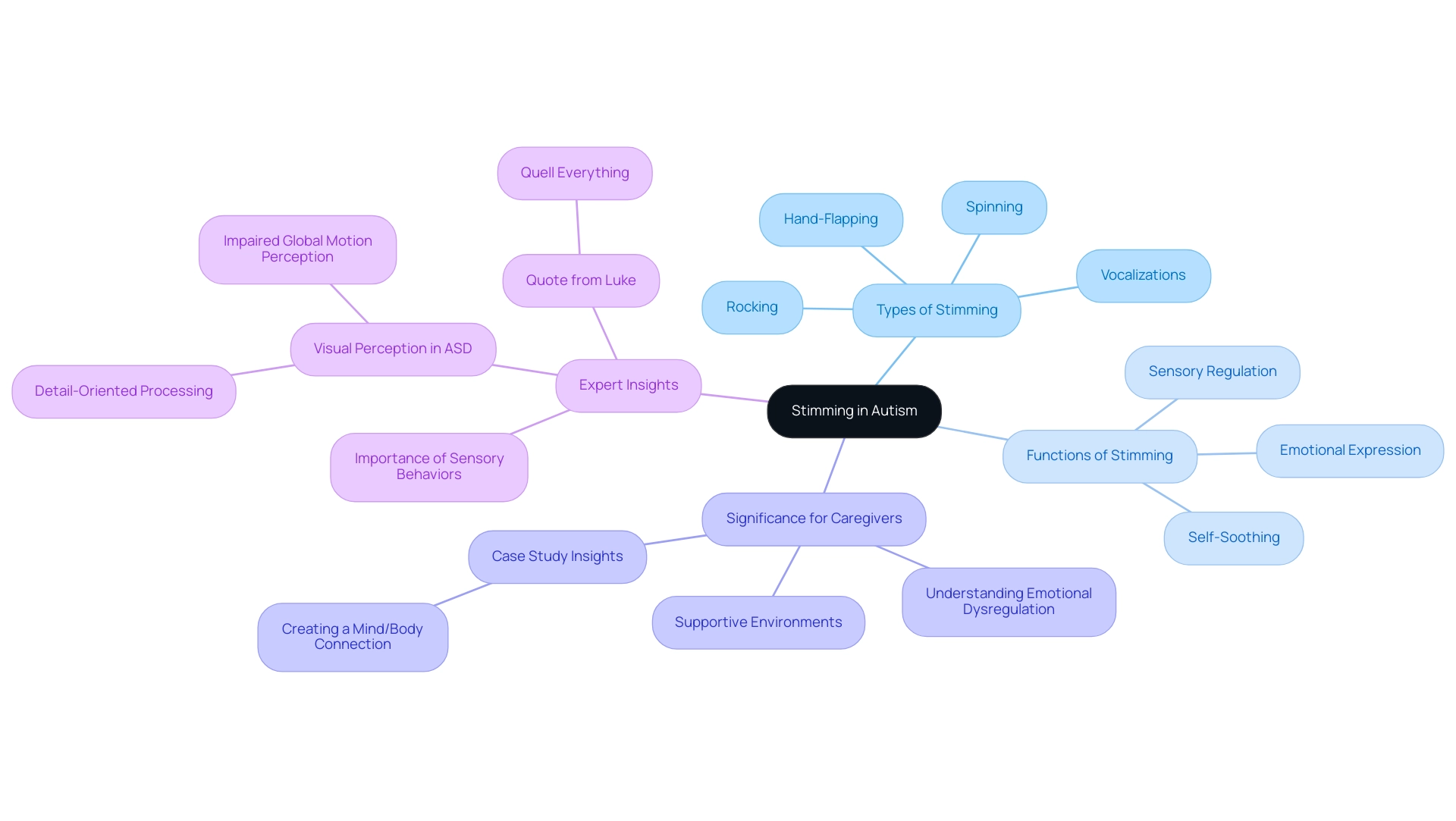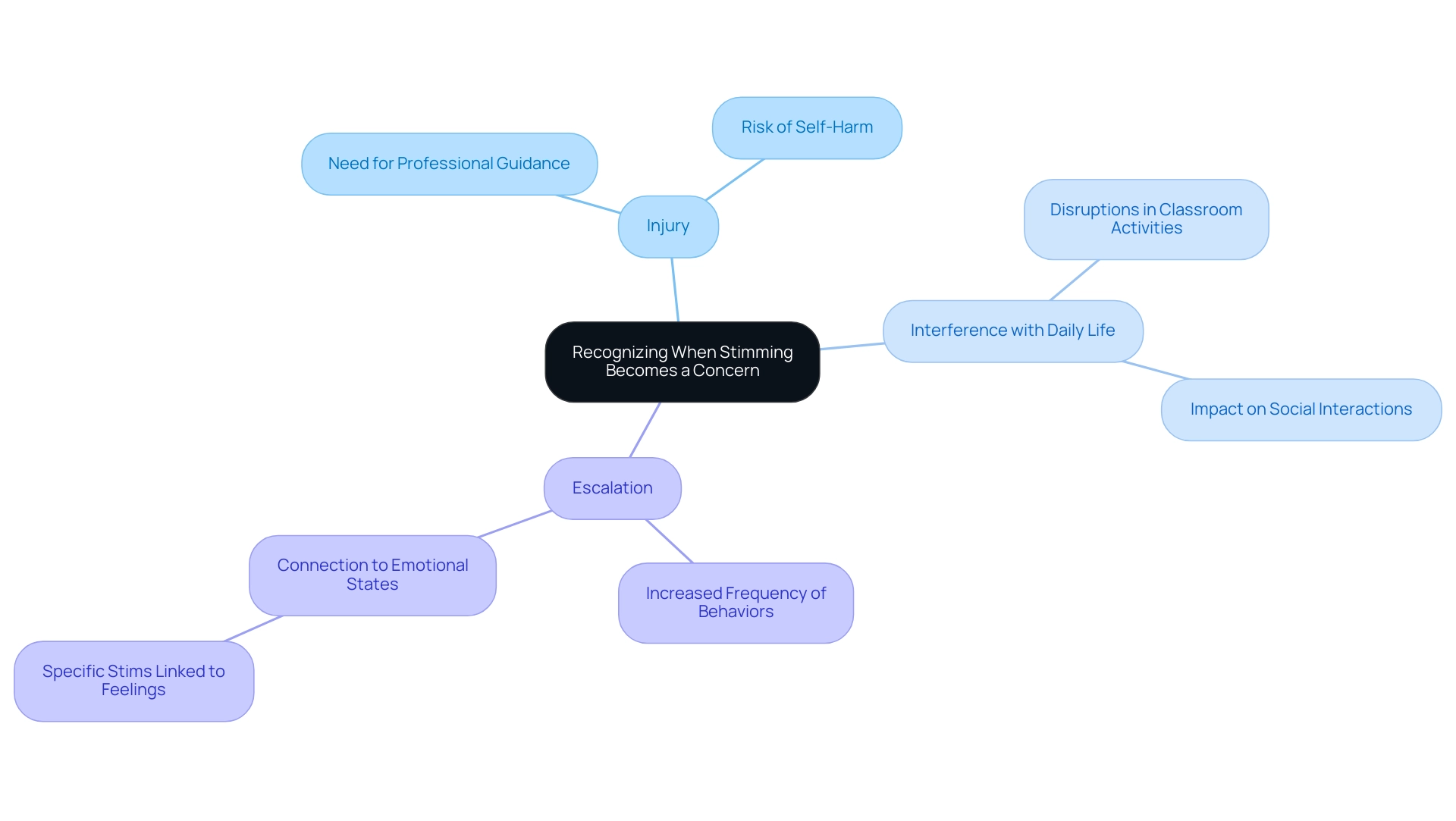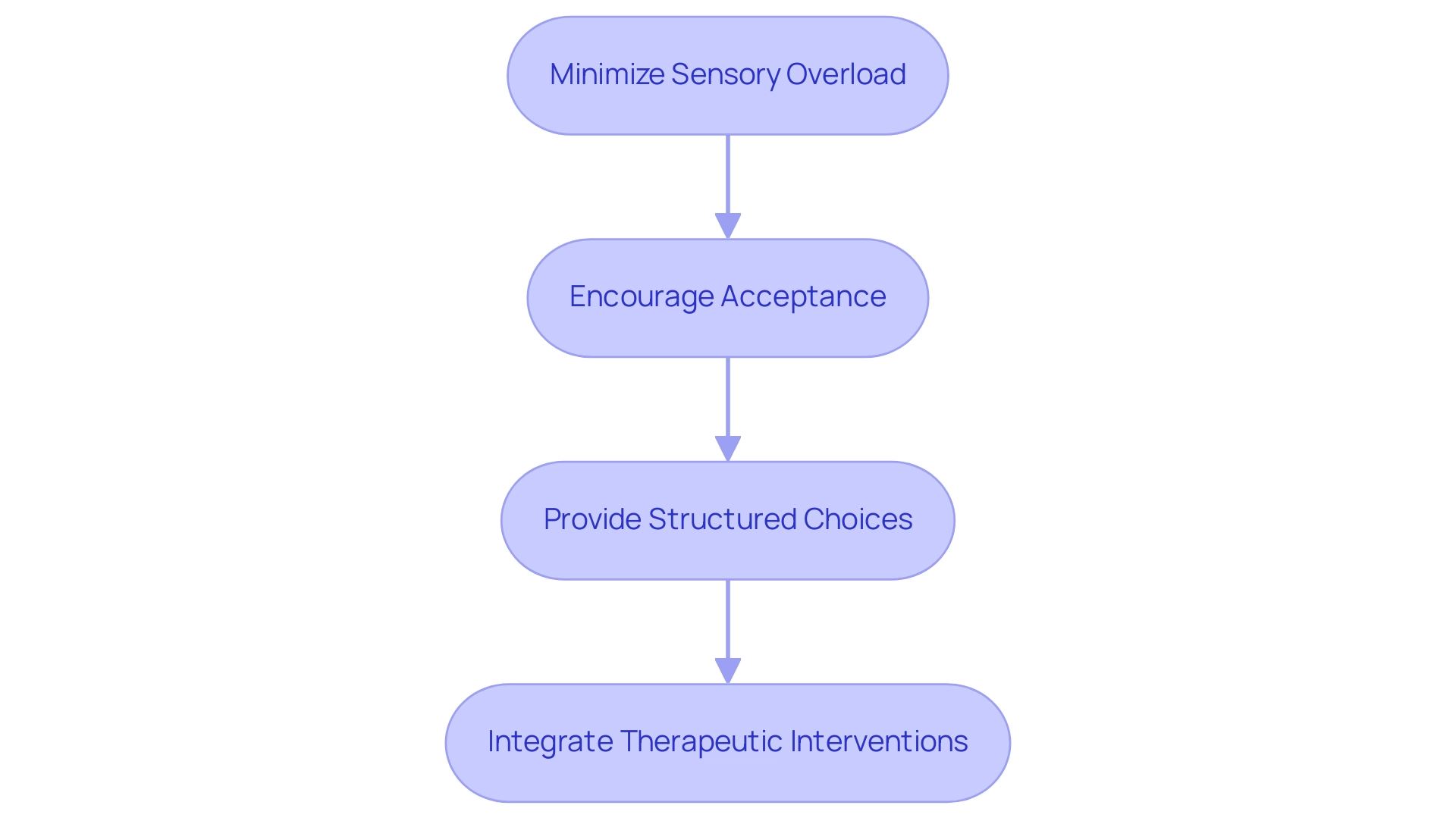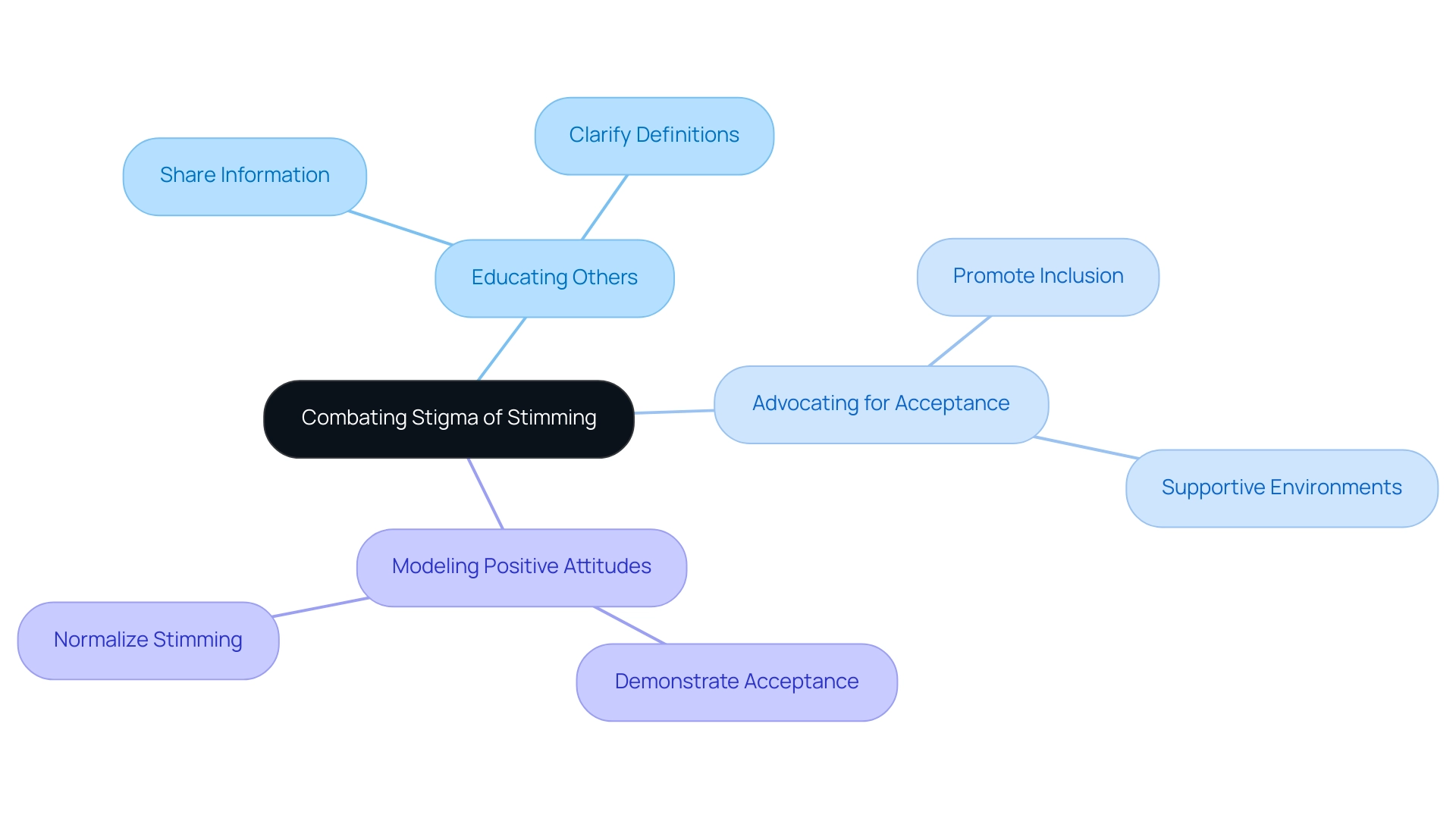Overview
This article highlights the significance of stimming in autism, particularly for caregivers who strive to understand and support individuals on the autism spectrum. Stimming behaviors are not just actions; they serve essential functions such as self-soothing, sensory regulation, and emotional expression. By recognizing these roles, caregivers can better assist individuals in managing overwhelming situations and communicating their feelings effectively.
Understanding stimming is crucial. It provides a window into the world of those on the spectrum, revealing how these behaviors can help navigate daily challenges. For instance, a child may engage in repetitive movements during stressful moments, finding comfort and stability in these actions. This insight can empower caregivers to respond with compassion and support.
As you explore this topic, consider the resources available to deepen your understanding. Engaging with communities, reading personal stories, and seeking professional guidance can significantly enhance your ability to support loved ones. Remember, you are not alone in this journey; many others share similar experiences and insights.
By embracing the complexities of stimming, you can foster a nurturing environment that acknowledges and respects the unique needs of individuals on the autism spectrum.
Introduction
In the intricate world of autism, stimming—short for self-stimulatory behavior—holds immense significance for many individuals. These repetitive movements and sounds, whether hand-flapping or vocalizations, are not simply quirks; they serve as essential tools for self-soothing, sensory regulation, and emotional expression. As caregivers seek to understand the importance of stimming, they often discover its profound influence on emotional management and daily functioning. This article invites you to explore the various facets of stimming, including its definitions, types, and the reasons behind its occurrence. Additionally, it offers effective strategies for supporting individuals with autism. By nurturing a deeper understanding of stimming, caregivers can create environments that empower individuals to navigate their sensory experiences and enhance their quality of life.
Defining Stimming: What Caregivers Need to Know
Stimming, short for self-stimulatory conduct, is a term that describes a variety of repetitive movements or sounds that individuals, particularly those on the autism spectrum, may display. Common forms include hand-flapping, rocking, spinning, and various vocalizations. These behaviors are not just quirks; they serve essential functions in the lives of many autistic people, such as self-soothing, sensory regulation, and emotional expression.
Understanding the concept of stimming is crucial for caregivers, as it is a prevalent characteristic of autism. Research shows that self-stimulatory behaviors can help individuals manage emotional dysregulation, enabling them to maintain a sense of calm in overwhelming situations. Many have learned to consciously use self-soothing techniques to prevent emotional upheaval, highlighting its proactive role in emotional management.
For instance, a case study titled "Creating a Mind/Body Connection in Non-Speaking Autistic Individuals" illustrates how self-stimulatory behavior can bridge intent and movement, aiding in the initiation and completion of actions. The study concludes that quick motor mannerisms can enhance the mind/body connection, which is particularly vital for non-speaking individuals who may struggle to express their needs and desires.
Statistics reveal that a significant number of children with autism engage in self-stimulatory activities, with many caregivers recognizing its importance in their daily routines. For example, Greg's spouse, who worked for an autism advocacy group, understood the value of these behaviors and encouraged her husband to partake in them. This understanding demonstrates how supportive environments can boost the well-being of autistic individuals, allowing them to flourish.
Additionally, expert opinions stress the importance of understanding sensory behaviors for effective autism care. Experts note that acknowledging and affirming these actions can lead to improved management techniques, ultimately fostering a more supportive environment for those with autism. As one specialist succinctly put it, self-soothing enables individuals to 'quell everything, because you’re at the same rhythm with everything.'
Furthermore, visual perception in individuals with autism often involves detail-oriented processing, which can influence their repetitive actions. While they may excel at noticing single details, they frequently face challenges with global motion perception. This aspect of sensory processing is crucial for understanding the context in which self-soothing behaviors occur.
In conclusion, the definition of stimming reveals that these actions are a fundamental aspect of autism that caregivers must grasp. By acknowledging the prevalence and significance of these behaviors, caregivers can respond more effectively, offering the necessary support to help individuals navigate their experiences and enhance their quality of life.

Exploring the Types of Stimming Behaviors in Autism
Stimming behaviors in individuals with autism can be classified into several distinct categories, each serving unique sensory needs.
- Visual Stimming: Engaging with lights or patterns, such as spinning objects, watching moving visuals, or focusing on bright colors, offers visual stimulation that can be soothing or thrilling for the person.
- Auditory Stimming: This includes making repetitive sounds, such as humming, tapping, or vocalizations, which assist individuals in self-soothing or expressing emotions comfortably.
- Tactile Stimming: Involving the sense of touch, tactile stimming includes actions like rubbing different textures, fidgeting with objects, or squeezing items, satisfying a need for input through physical contact.
- Vestibular Stimming: This type encompasses movements involving balance and spatial orientation, such as rocking, swinging, or spinning, providing a feeling of movement and helping regulate perception.
Recognizing these categories is essential for caregivers. It enables them to identify the specific self-soothing actions related to the autism stimming definition that their child displays and comprehend the needs being addressed. Studies show that a notable percentage of people with autism engage in these self-stimulatory actions, which align with the autism stimming definition. Typical activities include nail biting, hair twisting, knuckle cracking, leg and foot jiggling, and pacing or walking on their toes. This highlights the importance of tailored management strategies.
Management strategies may involve recognizing triggers, adjusting the environment, and employing behavioral therapies that focus on personal preferences. As Rebecca poignantly expressed, "I felt ‘[a]angry that they’ve been told a thousand times why I do it, the reason behind it, that it’s not affecting anyone,’" illustrating the emotional perspective of individuals with autism regarding their repetitive behaviors.
Additionally, recognizing positive representations in the autism community, such as those highlighted in case studies of pop culture figures, can inspire and empower caregivers on their journey. Sharing experiences and insights can foster a supportive community, reminding us all that understanding and compassion are key in navigating these unique challenges.
Why Do Individuals with Autism Engage in Stimming?
Individuals with autism often engage in stimming for various reasons, each serving a unique purpose in their daily lives.
- Self-Regulation: Stimming acts as a vital tool for managing overwhelming emotions or sensory input. By engaging in repetitive movements or sounds, individuals can achieve a calming effect, which helps them navigate stressful situations more effectively.
- Sensory Seeking: Many individuals with autism actively seek sensory input to feel more grounded or connected to their surroundings. This behavior enhances their engagement with the environment, allowing them to explore and interact in ways that feel comfortable and fulfilling.
- Expression of Emotions: Stimming can also serve as a means of expressing a range of emotions, including excitement, anxiety, or frustration. For instance, a child may flap their hands when excited or rock back and forth when feeling overwhelmed. Understanding these emotional expressions through self-soothing actions is essential for caregivers, as it highlights the importance of acknowledging these responses as valid coping strategies rather than simple interruptions.
Research indicates that actions related to the autism stimming definition are often misunderstood, with negative perceptions overshadowing their significance. A recent study underscores the necessity for a deeper comprehension of these actions, promoting further investigation into their effects and the internal factors behind them, such as perceptual sensitivities and emotional dysregulation. Steven K Kapp notes that future researchers could explore autistic individuals' accounts regarding the supposed internal causes of their stims, including sensory (hyper)sensitivities, cognitive inflexibility, and emotional dysregulation.
Furthermore, understanding self-stimulatory actions is especially important in the realm of medication management. For example, during a study on aripiprazole, the most common adverse events included upper respiratory tract infection (10.3%), constipation (5.1%), and movement disorder (5.1%). This emphasizes the significance of recognizing self-regulation as a coping strategy that may alleviate some behavioral issues linked to medication side effects.
The case study titled "Relapse Prevention with Aripiprazole in Pediatric Patients" illustrates the real-world implications of self-stimulatory actions and their management in pediatric patients with autism. While the study found no statistically significant difference in time to relapse between aripiprazole and placebo, it suggests that some patients may benefit from maintenance treatment with aripiprazole, underscoring the need for a nuanced understanding of behavioral management strategies.
By fostering an empathetic approach, caregivers can better assist those with autism, recognizing that self-soothing behaviors are not only a coping strategy but also a vital aspect of their self-regulation and emotional expression. ASD Media's commitment to building a supportive community aligns with this understanding, as it encourages collaboration and growth within the ABA therapy industry.
The Role of Stimming in Sensory and Emotional Regulation
The definition of autism stimming highlights that stimming, or self-stimulatory activity, plays a vital role in perception and emotional regulation for individuals with autism. This behavior can fulfill several essential functions:
- Calm Overstimulation: Engaging in stimming activities can provide significant relief from overwhelming sensory environments. For instance, repetitive movements or sounds can help individuals manage sensory overload, allowing them to regain a sense of control and comfort in challenging situations.
- Express Emotions: Stimming often acts as a non-verbal communication tool, enabling individuals to convey emotions that may be difficult to articulate. This form of expression is crucial for emotional processing, assisting individuals in expressing feelings of anxiety, excitement, or frustration.
- Enhance Focus: For many, stimming can improve concentration during tasks by providing a necessary sensory outlet. This behavior can help individuals filter distractions, enabling them to engage more fully in their activities.
Research shows that a significant portion of individuals with autism—approximately 19.2%—report engaging in actions like picking or scratching their skin when bored, which aligns with the definition of autism stimming. This statistic underscores the prevalence of self-stimulatory behavior as a coping mechanism and highlights its importance in managing sensory experiences. Additionally, research on masking behaviors indicates that while some individuals may suppress their self-soothing actions to conform to societal norms, this often leads to negative experiences and mental health challenges.
The case study titled 'Masking and Its Implications' illustrates that although some participants found masking beneficial, it is generally a taxing process that can adversely affect mental health. This emphasizes the need for greater acceptance of self-soothing behaviors in society.
Expert insights suggest that a deeper understanding of autism stimming can lead to more effective support strategies for individuals with autism. As Steven K Kapp noted, "Greater understanding of such repetitive behaviors may, therefore, help elucidate appropriate support for a variety of people." Behavioral therapists advocate for recognizing the calming effects of self-stimulatory behaviors, emphasizing its legitimacy as a means of self-regulation.
By acknowledging and encouraging self-soothing behaviors, caregivers can create nurturing environments that empower individuals to manage their sensory and emotional needs effectively. Promoting neurodiversity and inclusion is crucial, as it helps recognize the strengths and perspectives of individuals with autism, fostering a more accepting environment for everyone.
Effective Strategies for Supporting and Managing Stimming Behaviors
To effectively support and manage self-soothing behaviors, caregivers can implement several key strategies that foster understanding and compassion:
- Create a Safe Space: Designate specific areas where individuals can engage in self-soothing without fear of judgment or interruption. These spaces should be cozy and equipped with comfort-oriented features that promote self-regulation and a sense of security.
- Provide Sensory Tools: Offering a variety of tactile items, such as fidget toys, stress balls, or textured materials, can serve as alternative outlets for self-soothing. Research indicates that these tools significantly enhance emotional regulation and provide comfort during overwhelming situations. A study involving interviews and focus groups with 32 autistic adults highlighted that the autism stimming definition includes repetitive behaviors that serve a self-soothing purpose, helping individuals cope with overwhelming sensory inputs.
- Establish Routines: Consistent daily routines can alleviate anxiety, reducing reliance on such behaviors as a coping mechanism. Regular timetables create a feeling of safety, enabling individuals to feel more in control of their surroundings.
By applying these approaches, caregivers honor the natural actions of individuals while promoting an awareness of the self-soothing function of repetitive movements, as highlighted in the autism stimming definition. As one autistic adult poignantly expressed, 'I quickly become overwhelmed [in social situations]. Is it surprising that I then feel like blocking the world out and literally putting my thoughts back in order?'
Creating supportive environments allows caregivers to enhance the quality of life for those they support. Recent studies advocate for greater societal acceptance and comprehension of self-stimulatory actions, emphasizing that these techniques are essential in encouraging such acceptance.
Recognizing When Stimming Becomes a Concern: Signs and Solutions
Self-soothing actions can often feel like a natural response for many individuals on the autism spectrum. However, there are specific signs within the autism stimming definition that may indicate these behaviors have become concerning. Caregivers, your vigilance is key—watch for these important indicators:
- Injury: If stimming behaviors lead to self-harm or physical injury, it’s essential to seek professional guidance. Research shows that a significant percentage of individuals with autism may engage in self-stimulatory behaviors that can result in injury. This highlights the importance of careful monitoring and timely intervention.
- Interference with Daily Life: When self-soothing behaviors disrupt vital daily activities, social interactions, or learning experiences, intervention may be necessary. For instance, if a child’s repetitive actions prevent them from participating in classroom activities or engaging with classmates, addressing these behaviors promptly is crucial.
- Escalation: An increase in the frequency or intensity of self-stimulatory behaviors can signal underlying stress or anxiety. Studies indicate that the degree of connection to the autistic community is a key predictor of whether these behaviors serve social-communication functions. Variations in these patterns may reflect emotional states. A case study titled 'Exploring the Link Between Sensory Behaviors and Emotions' underscores the significance of these behaviors as responses to emotions, suggesting that different actions may correlate with specific feelings.
As Steven K Kapp from the University of Exeter notes, this research, co-produced by autistic self-advocates and non-autistic researchers, aims to deepen our understanding of repetitive behaviors from the perspectives of autistic adults. Recognizing these signs empowers caregivers to take proactive steps in seeking support or intervention. By grasping the nuances of self-stimulatory behavior, caregivers can navigate the complexities of the autism stimming definition and enhance the well-being of those they support.

Creating a Safe and Supportive Environment for Stimming
To cultivate a safe and supportive environment for stimming, caregivers can implement several key strategies:
- Minimize Sensory Overload: Reducing excessive noise, bright lights, and other sensory triggers is crucial for creating comfort. Many individuals, especially those with autism, can feel overwhelmed by stimuli. Research shows that understanding the autism stimming definition can lead to significant improvements in comfort levels. As noted by Allen and Courchesne, heightened reactivity to seemingly meaningless stimuli may relate to distractibility, highlighting the importance of minimizing sensory triggers.
- Encourage Acceptance: Fostering an atmosphere where self-regulatory behaviors are accepted and understood is vital. This approach not only reduces stigma but also promotes self-expression, allowing individuals to feel more at ease with their behaviors. Experts emphasize that understanding the autism stimming definition can enhance emotional regulation and overall well-being.
- Provide Structured Choices: Empowering individuals to choose when and how they engage in stimming can enhance their sense of control over their needs. This autonomy is essential for managing perceptual experiences effectively. Notably, gender disparities in perception processing among ASD children indicate that females may exhibit more severe symptoms, underscoring the need for tailored approaches in creating supportive environments.
Creating such an environment can significantly enhance the comfort and well-being of people who stim. A case study titled "Resources for Managing Sensory Issues" outlines various therapeutic interventions, such as occupational therapy and cognitive behavioral therapy, which can further support individuals in navigating their perceptual experiences. By integrating these strategies, caregivers can play a pivotal role in enhancing the quality of life for those who engage in self-stimulatory behavior, as described in the autism stimming definition.
Furthermore, ongoing research emphasizes the need for optimizing interventions to better understand sensory processing and self-stimulatory behaviors, reinforcing the importance of caregiver strategies.

Understanding the Stigma of Stimming: Advocacy and Acceptance
Stimming actions, often misunderstood, carry significant stigma due to societal misconceptions surrounding the autism stimming definition. Caregivers play a crucial role in combating this stigma by employing several effective strategies.
- Educating Others: Sharing information about repetitive behaviors and their essential role in self-regulation fosters understanding among peers, educators, and the broader community. By clarifying the autism stimming definition—self-stimulatory actions as a natural and often advantageous practice—caregivers can help dispel myths and diminish negative perceptions.
- Advocating for Acceptance: Promoting acceptance of self-stimulatory actions in educational and community environments is vital. This advocacy nurtures a culture of inclusion, allowing individuals to express themselves freely without fear of judgment. Case studies have shown that when family and peers comprehend and embrace these actions, individuals feel more at ease expressing them, enhancing their emotional well-being. The examination revealed that support from family and peers significantly impacts the acceptance of self-regulatory actions, underscoring the importance of a nurturing atmosphere.
- Modeling Positive Attitudes: Demonstrating acceptance and understanding of self-regulatory actions in daily interactions is crucial. Caregivers can model a positive response to self-stimulatory actions, promoting their acceptance and normalizing these activities in social settings.
Addressing the stigma associated with self-stimulatory actions not only aids those who participate in these activities but also cultivates a more supportive environment overall. Studies suggest that prolonged suppression of self-stimulatory actions can lead to significant mental health issues, including increased risks of suicidality. Therefore, fostering an atmosphere of acceptance is not just beneficial; it is essential for the well-being of autistic individuals.
As Catherine RG Jones, PhD, noted, autistic individuals face a range of stressors common to minority groups, including victimization and discrimination. By actively working to reduce stigma, caregivers can empower those they support to embrace their authentic selves. The neurodiversity movement further underscores the importance of recognizing autism as a natural variation in human development, advocating for greater acceptance of non-harmful stimming behaviors that align with the autism stimming definition.

Conclusion
Understanding the significance of stimming is crucial for caregivers and anyone involved in the lives of individuals with autism. Stimming behaviors, such as hand-flapping and vocalizations, serve essential functions, including self-soothing, sensory regulation, and emotional expression. By recognizing the various types of stimming and the underlying reasons individuals engage in these behaviors, caregivers can create a supportive environment that respects and nurtures their needs.
Caregivers can implement effective strategies to foster this supportive environment. Creating safe spaces, providing sensory tools, and establishing routines are vital approaches. These not only validate stimming as a natural part of the autism experience but also help individuals manage their sensory and emotional needs more effectively. Moreover, being vigilant for signs that stimming may become a concern allows caregivers to intervene appropriately while respecting the individual’s autonomy.
Advocacy and education play pivotal roles in combating the stigma surrounding stimming behaviors. By promoting acceptance and understanding within the community, caregivers can help dismantle misconceptions and create an inclusive atmosphere. This advocacy is essential not only for the well-being of individuals who stim but also for fostering a culture that celebrates neurodiversity.
Ultimately, embracing and supporting stimming behaviors can significantly enhance the quality of life for individuals with autism. By fostering understanding, acceptance, and tailored support, caregivers can empower these individuals to navigate their sensory experiences and express themselves authentically. Together, we can pave the way for a more inclusive society, where everyone feels valued and understood.
Frequently Asked Questions
What is stimming?
Stimming, short for self-stimulatory conduct, refers to a variety of repetitive movements or sounds that individuals, particularly those on the autism spectrum, may display. Common forms include hand-flapping, rocking, spinning, and various vocalizations.
Why do individuals engage in stimming behaviors?
Stimming behaviors serve essential functions such as self-soothing, sensory regulation, and emotional expression. They help individuals manage emotional dysregulation and maintain a sense of calm in overwhelming situations.
How can stimming aid non-speaking autistic individuals?
Stimming can help bridge intent and movement, aiding in the initiation and completion of actions. It enhances the mind/body connection, which is particularly vital for non-speaking individuals who may struggle to express their needs and desires.
What do statistics say about stimming in children with autism?
A significant number of children with autism engage in self-stimulatory activities, and many caregivers recognize the importance of these behaviors in their daily routines.
How can caregivers support individuals who stim?
Caregivers can support individuals by understanding the significance of stimming behaviors, creating supportive environments, and employing management techniques that acknowledge and affirm these actions.
What are the different categories of stimming behaviors?
Stimming behaviors can be classified into four categories: Visual Stimming (engaging with lights or patterns), Auditory Stimming (making repetitive sounds), Tactile Stimming (involving the sense of touch through actions like rubbing textures), and Vestibular Stimming (movements involving balance and spatial orientation).
Why is it important for caregivers to recognize the categories of stimming?
Recognizing these categories helps caregivers identify specific self-soothing actions and understand the sensory needs being addressed by the individual.
What are some common examples of stimming behaviors?
Common stimming behaviors include nail biting, hair twisting, knuckle cracking, leg and foot jiggling, and pacing or walking on toes.
What management strategies can be employed for stimming?
Management strategies may involve recognizing triggers, adjusting the environment, and using behavioral therapies that focus on personal preferences.
How can positive representations in the autism community help caregivers?
Positive representations, such as case studies of pop culture figures, can inspire and empower caregivers by fostering a supportive community and emphasizing understanding and compassion in navigating the unique challenges of autism.




